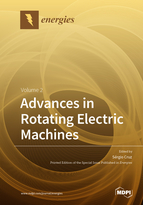Advances in Rotating Electric Machines
A special issue of Energies (ISSN 1996-1073). This special issue belongs to the section "F: Electrical Engineering".
Deadline for manuscript submissions: closed (31 March 2020) | Viewed by 164955
Special Issue Editor
2. Instituto de Telecomunicações, Pólo 2-Pinhal de Marrocos, P-3030-290 Coimbra, Portugal
Interests: rotating electric machines; power transformers; electric drives and power electronic converters; fault diagnosis; fault tolerance and digital control
Special Issues, Collections and Topics in MDPI journals
Special Issue Information
Dear Colleagues,
It is difficult to imagine a modern society without rotating electric machines. Their use has been increasing not only in the traditional fields of application but also in more recent areas, including renewable energy conversion systems, electric aircraft, aerospace, electric vehicles, unmanned propulsion systems, robotics, etc. This has contributed to the advances in the materials, design methodologies, modelling tools and manufacturing processes of current electric machines, which are characterized by a high compactness, low weight, high power density, high torque density, and high reliability. On the other hand, the growing use of electric machines and drives in more critical applications has pushed forward the research in the area of condition monitoring and fault tolerance, leading to the development of more reliable diagnostic techniques and more fault-tolerant machines.
This Special Issue aims to present and disseminate the most recent advances related to the theory, design, modelling, application, control, and condition monitoring of all types of rotating electric machines.
Topics of interest for publication include, but are not limited to:
- All aspects of induction machines, permanent magnet synchronous machines, synchronous reluctance machines, switched reluctance machines, brushless dc machines and emerging PM machines, among others
- Electric motor/generator technologies for more electric aircraft, electric vehicles and wind energy conversion systems
- Machines for safety-critical applications
- Novel applications of electric machines
- Multiphase machines and drives
- Modular machines
- Fault-tolerant machines
- Online and offline condition monitoring techniques
- Optimal design methodologies
- Advanced modelling approaches
- Thermal and vibroacoustic analyses
Prof. Dr. Sérgio Cruz
Guest Editor
Manuscript Submission Information
Manuscripts should be submitted online at www.mdpi.com by registering and logging in to this website. Once you are registered, click here to go to the submission form. Manuscripts can be submitted until the deadline. All submissions that pass pre-check are peer-reviewed. Accepted papers will be published continuously in the journal (as soon as accepted) and will be listed together on the special issue website. Research articles, review articles as well as short communications are invited. For planned papers, a title and short abstract (about 100 words) can be sent to the Editorial Office for announcement on this website.
Submitted manuscripts should not have been published previously, nor be under consideration for publication elsewhere (except conference proceedings papers). All manuscripts are thoroughly refereed through a single-blind peer-review process. A guide for authors and other relevant information for submission of manuscripts is available on the Instructions for Authors page. Energies is an international peer-reviewed open access semimonthly journal published by MDPI.
Please visit the Instructions for Authors page before submitting a manuscript. The Article Processing Charge (APC) for publication in this open access journal is 2600 CHF (Swiss Francs). Submitted papers should be well formatted and use good English. Authors may use MDPI's English editing service prior to publication or during author revisions.
Keywords
- electric machines
- standard and new topologies
- new applications
- modelling
- design
- control
- fault diagnosis
- fault tolerance






